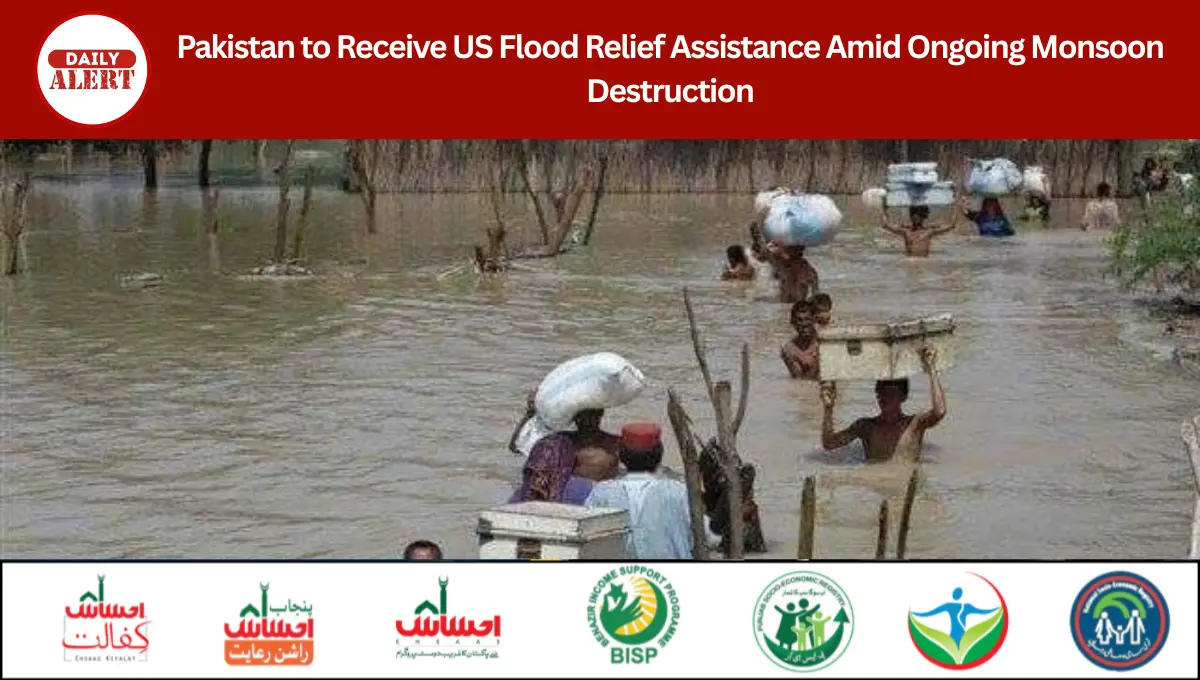Pakistan is set to receive relief assistance from the United States as the country struggles under severe flooding caused by unusually intense monsoon rains and river overflows. The US has approved emergency funds and dispatched flights with supplies to assist communities hit hardest in Punjab and other areas. The aid comes at a moment when thousands have been displaced, crops destroyed, and infrastructure damaged, underscoring the urgency of relief efforts.
Background of the Monsoon Crisis in Pakistan
Monsoon rains since late June 2025 have triggered widespread flooding across Pakistan. Rivers such as the Ravi, Sutlej, and Chenab—some swelling due to upstream dam water releases—have overflowed, particularly affecting eastern Punjab. As of early September, over 900 people have died nationwide from rain‐ and flood‐related incidents.
The floods have destroyed vast tracts of agricultural land, submerged thousands of villages, damaged roads and bridges, and forced the evacuation of hundreds of thousands of residents. The National Disaster Management Authority (NDMA) reports millions of people in need of assistance.
Details of the US Relief Assistance
The United States has approved a relief assistance package that includes funding for food, shelter, and other emergency support in regions most affected by flooding. The State Department has committed to working with Pakistani authorities and humanitarian organizations for delivery and distribution of aid.
Part of the aid involves six flights carrying essential relief items such as tents, dewatering pumps, and generators. The first of these consignment flights has already arrived at Nur Khan Air Base and the supplies have been handed over to the Pakistan Army for onward distribution to flood relief camps.
The US relief response also includes rapid deployment of disaster response personnel. Within a few days of approving the funding, the US has moved to coordinate logistics and begin delivering assistance to affected populations.
Analysis: Challenges and Implications
The flooding crisis in Pakistan presents both immediate and longer‐term challenges. Immediate issues include ensuring displaced people have access to clean water, food, shelter, and medical facilities. Floodwaters, damaged roads, and inundated areas complicate relief operations.
Agricultural damage is particularly serious in Punjab, a region that produces much of Pakistan’s staple crops. More than a million acres of farmland are reported to have been flooded, threatening food security and livelihoods.
Meanwhile, climate factors are aggravating the situation. Experts point out that intensified monsoon rains, glacial melt, and deficient early‐warning infrastructure increase vulnerability. Cross‐border coordination with India over water releases from dams also plays a role in how floodwaters move downstream.
Another challenge lies in the scale of displacement and need. Relief organizations warn that resources are stretched thin, with many communities in remote or difficult‐to‐access areas lacking sufficient aid. Health risks, especially from waterborne diseases, loom large as floodwaters linger and sanitation systems are compromised.
What This Aid Means for Pakistan
The US relief assistance, while essential, is one component of a broader humanitarian and disaster management effort. The flow of aid may help reduce immediate suffering, enable faster rescue operations, and provide relief to affected families. It may also ease strain on Pakistan’s national and provincial governments in mobilizing resources and saving lives.
However, for meaningful impact, this aid must be well coordinated with local authorities, NGOs, and community leaders; distribution must reach remote and vulnerable populations; and the information on where resources are most needed must be accurate and timely.
Conclusion and Future Outlook
As Pakistan braces for continued monsoon rains and rising river levels, the US assistance arrives at a crucial time. The coming weeks will be decisive in how well relief efforts mitigate further loss of life and damage. Authorities will need to focus not only on emergency relief but also on rebuilding infrastructure, restoring agricultural production, and strengthening early warning systems.
In the longer term, Pakistan faces the ongoing need to invest in climate resilience, improved flood planning, and cross‐border water management. International aid, including from the US, can provide temporary relief—but structural change will be essential to reduce vulnerability during future monsoon seasons.
Also Read More: Floods destroy 1.3 million acres of farmland in Pakistan

